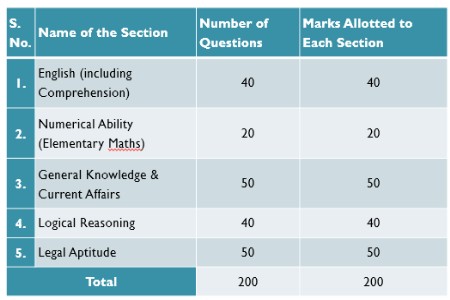COMMON LAW ADMISSION TEST
The Common Law Admission Test is an all India common entrance exam, which is conducted by the one of the 19 National Law Universities on a rotational basis for their Undergraduate (UG) or Postgraduate (PG) courses. Students are offered admission in the 5-year integrated undergraduate law programme of different NLUs
Common Law Admission Test (CLAT) - Exam Details
Common Law Admission Test (CLAT) is the most coveted of all the law entrances in India after Class XII. CLAT journey started in 2008 and today more than 40,000 students write the entrance every year to secure a seat in one of the participating National Law University including NLSIU Bangalore-the Harvard of the East.
CLAT is conducted every year to select students for 19 National Law Universities in India, other than National Law University-Delhi and HP National Law University-Shimla, which have their own process to select the students.
CLAT Score is also accepted by other law schools including NMIMS, Mumbai, UPES Dehradun and Nirma University, Ahmedabad, to name a few.
The following National Law Universities (along with intake) accept CLAT scores to admit students to their five year LLB programs every year:
LIST OF NATIONAL LAW UNIVERSITY
1.National Law School of India University, Bangalore (NLSIU)
2.National Academy of Legal Study and Research University of Law, Hyderabad (NALSAR)
3.The National Law Institute University, Bhopal(NLIU)
4.The West Bengal National University of Juridical Sciences, Kolkata (WBNUJS)
5.National Law University, Jodhpur (NLUJ)
6.Hidayatullah National Law University, Raipur (HNLU)
7.Gujarat National Law University, Gandhinagar (GNLU)
8.Dr. Ram Manohar Lohiya National Law University, Lucknow (RMLNLU)
9.Rajiv Gandhi National University of Law, Punjab (RGNUL)
10.Chanakya National Law University, Patna (CNLU)
11.The National University of Advanced Legal Studies, Kochi (NUALS)
12.National Law University Odisha, Cuttack (NLUO)
13.National University of Study and Research in Law, Ranchi (NUSRL)
14.National Law University and Judicial Academy, Assam (NLUJAA)
15.Damodaram Sanjivayya National Law University, Visakhapatnam (DSNLU)
16.Tamil Nadu National Law School, Tiruchirappalli (TNNLS)
17.Maharashtra National Law University, Mumbai (MNLU)
18.Himachal Pradesh National Law University, Shimla
19.Dharmashastra National Law University, Jabalpur
|
National Law University |
Location |
Intake# |
|
Bangalore |
80 |
|
|
Hyderabad |
120 |
|
|
Bhopal |
128 |
|
|
Kolkata |
133 |
|
|
Jodhpur |
115 |
|
|
Raipur |
187 |
|
|
Gandhinagar |
187 |
|
|
Lucknow |
178 |
|
|
Patiala |
196 |
|
|
Patna |
140 |
|
|
Kochi |
68 |
|
|
Cuttack |
180 |
|
|
Ranchi |
120 |
|
|
Guwahati |
60 |
|
|
Vishakhapatnam |
120 |
|
|
Tiruchirappalli |
110 |
|
|
Mumbai |
60 |
|
|
Nagpur |
60 |
Eligibility for CLAT
There will be no upper age limit for UG Programme in CLAT 2019.
As regards minimum percentage of marks in the qualifying examination (i.e., 10+2), the candidates must have secured:
Forty five percent (45%) marks in case of candidates belonging to Unreserved/OBC/Specially Abled Persons (SAP) and other categories, and
Forty Percent (40%) marks in case of candidates belonging to Scheduled Caste/Scheduled Tribe (SC/ST) categories.
Candidates who are appearing in the qualifying examination in March/April, 2018 are also eligible to appear in CLAT-2018 online examination. The result of the qualifying examination (i.e., 10+2) shall be submitted by the candidate at the time of admission failing which the candidate shall be ineligible for admission to the Course.
Exam Pattern
CLAT exam 2019 will consist of total 5 sections and will be conducted offline. Here is the exam pattern of this year’s CLAT exam: (Duration 2 hours)
